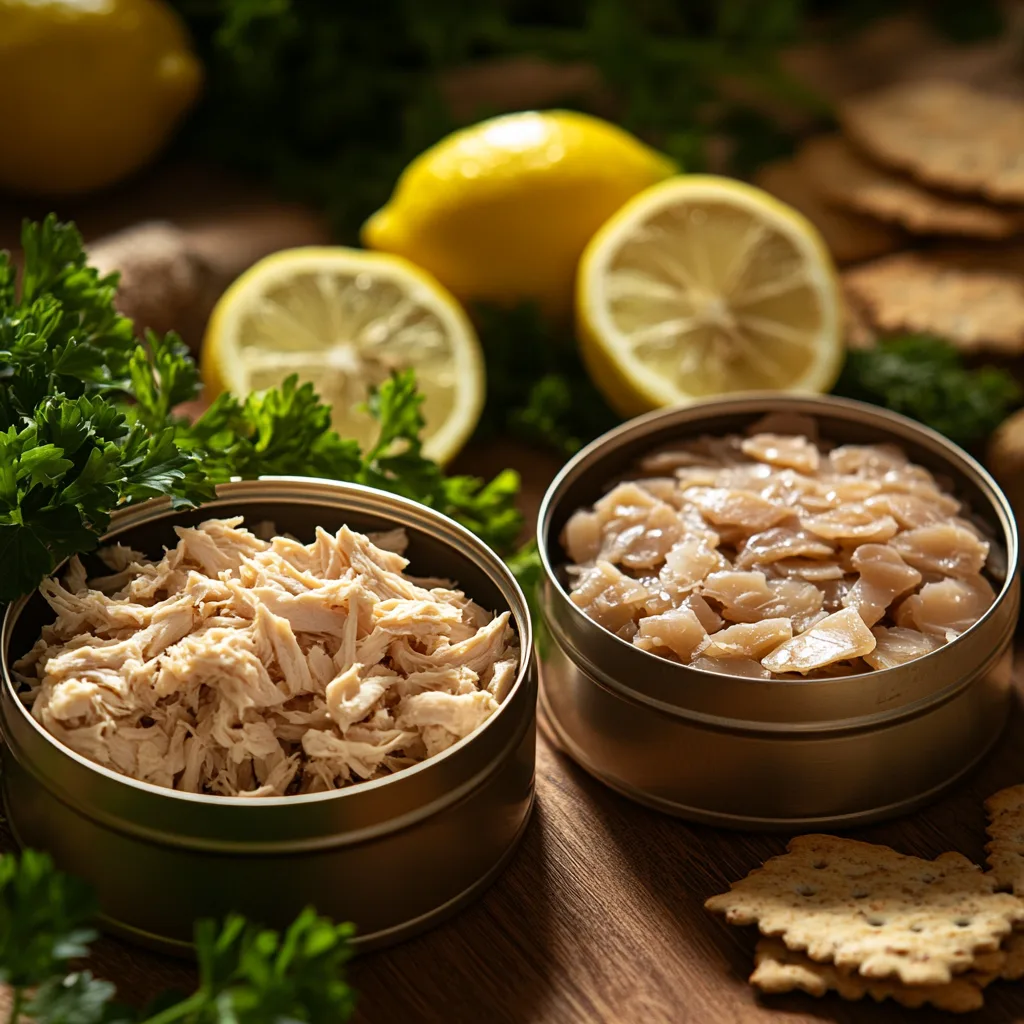Introduction: Pantry Proteins on the Rise
With busy lifestyles and rising grocery costs, many people are turning to canned meats like canned chicken and canned tuna as quick, convenient sources of protein. But a common question arises: Is canned chicken as healthy as canned tuna?
These two pantry staples often end up in salads, wraps, or even rice bowls like this high-protein chicken rice bowl, yet their health benefits can differ based on several key factors.
Some meals, like grilled chicken with roasted vegetables, highlight how lean poultry offers clean protein. Others use fish-based options for their heart-healthy fats. But when preserved in cans, how do they compare?
Nutritional Snapshot: What’s Inside the Can?
To understand which is healthier, we need to look at the nutritional profiles of both canned chicken and canned tuna. We’ll compare calories, protein content, fat, sodium, and key micronutrients.
Canned Chicken (per 3 oz serving):
- Calories: ~140
- Protein: ~26g
- Total Fat: ~3g (less than 1g saturated fat)
- Sodium: ~280mg (varies by brand)
- Cholesterol: ~60mg
- Micronutrients: niacin, B6, phosphorus
Canned Tuna (in water, light, per 3 oz serving):
- Calories: ~100
- Protein: ~22g
- Total Fat: ~1g
- Sodium: ~200mg
- Cholesterol: ~30mg
- Micronutrients: B12, selenium, iodine, omega-3s
For detailed nutrition breakdowns, visit the USDA FoodData Central.
Protein Showdown: Who Packs More Punch?
Both canned meats offer a solid amount of protein, making them great for muscle building, weight loss, or balanced diets. However:
- Canned chicken offers slightly more protein per serving (~26g vs ~22g)
- Tuna has a more complete amino acid profile, ideal for recovery
- Both are lean protein options — low in saturated fat and carbs
This makes both suitable for meals focused on fitness, like nutritious soups using canned proteins or grain bowls.
Omega-3s: Tuna’s Superpower
Where tuna shines is in its content of omega-3 fatty acids. These are essential for:
- Heart health
- Brain function
- Reducing inflammation
Light tuna contains around 150–300 mg omega-3s per 3 oz serving. Canned chicken has virtually none. According to Harvard Health, regular omega-3 intake is linked to a reduced risk of heart disease and cognitive decline.
Fat Content: Low in Both, but Tuna Wins
Both meats are naturally low in fat — especially if canned in water, not oil. But tuna’s fat is mostly unsaturated and includes heart-healthy omega-3s, while chicken contains more saturated fat (though still minimal).
- Canned tuna (in water): ~1g fat, mostly unsaturated
- Canned chicken: ~3g fat, some saturated
However, tuna canned in oil can raise total fat content significantly — so check the label.
Sodium, Additives & Shelf Life
This is where things get tricky. Both canned meats can contain added salt and preservatives.
Canned Chicken:
- Often contains broth or added flavoring
- Sodium ranges from 250–400mg per serving
- May contain modified food starch
Canned Tuna:
- Usually simpler ingredients (tuna, water/oil, salt)
- Lower sodium if labeled “no salt added”
- Minimal additives, but mercury risk (see below)
Look for BPA-free lining and no-salt-added versions of both. For safe seafood choices, check FDA seafood guidelines regarding mercury content.
Mercury Levels: The Big Tuna Question
Mercury is naturally found in fish and can accumulate in tuna, especially large species like albacore. Here’s what to know:
- Light tuna: Lower mercury (~0.12 ppm)
- Albacore/white tuna: Higher mercury (~0.35 ppm)
The FDA recommends limiting white tuna to 1 serving per week, especially for pregnant women and young children.
Canned chicken has no mercury concerns, making it safer for daily or frequent consumption.
Micronutrient Profile Comparison
Canned Tuna Is Higher In:
- Vitamin B12: Supports nerve function
- Selenium: Antioxidant support
- Iodine: Supports thyroid health
Canned Chicken Is Higher In:
- Niacin (B3): Helps convert food to energy
- Phosphorus: Bone and tooth strength
- Zinc: Immune health
Both have excellent nutritional value — the choice depends on your current dietary needs.
Which One Is Better for Special Diets?
Heart Health:
- Tuna: Higher in omega-3s and lower in saturated fat
Pregnant Women & Kids:
- Chicken: Safer due to mercury-free content
Keto/Low-Carb Diets:
- Both: Excellent high-protein, low-carb choices
Paleo or Clean Eating:
- Chicken: Less processed if you choose minimally seasoned versions
Choosing between the two often comes down to taste, texture, and health priorities.
Environmental Impact & Sustainability
Beyond nutrition, sustainability is a growing factor when comparing canned chicken and canned tuna. How do these two stack up from an ecological perspective?
🐟 Tuna Sustainability
- Tuna populations have been affected by overfishing, especially albacore and bluefin.
- Look for MSC-certified (Marine Stewardship Council) or “pole-and-line caught” labels to ensure sustainable sourcing.
- Some brands, like Wild Planet and Safe Catch, focus on low-mercury, eco-friendly practices.
🐔 Chicken Sustainability
- Raising chickens typically uses fewer ocean resources, but industrial farming raises ethical concerns.
- Choose antibiotic-free and certified humane brands when possible.
- Packaging and shelf-stable formats can reduce food waste and energy usage.
Neither is perfect — but mindful sourcing can make both protein options more environmentally responsible.
How to Choose the Healthiest Canned Options
The nutritional quality of canned meat depends heavily on how it’s processed and packaged. Here’s what to look for when shopping:
🛒 Canned Tuna Tips:
- Opt for tuna in water over oil
- Choose light tuna over albacore to reduce mercury
- Look for low sodium or “no salt added” versions
🛒 Canned Chicken Tips:
- Select chicken packed in water, not broth
- Avoid flavored versions with additives
- Go for organic or minimally processed labels
Shop smart by reading labels closely — and check for BPA-free packaging to reduce chemical exposure in long-term consumption.
Healthy Recipe Ideas Using Canned Chicken and Tuna
Both canned proteins are versatile. Below are some easy, healthy meal ideas for each:
🥗 With Canned Chicken:
- Greek Yogurt Chicken Salad: Mix chicken, Greek yogurt, mustard, celery, and grapes for a high-protein lunch.
- Low-Carb Chicken Lettuce Cups: Stir in some soy sauce, ginger, and water chestnuts — serve in butter lettuce leaves.
- Protein Wrap: Roll chicken with hummus, spinach, and peppers in a whole-wheat wrap.
🐟 With Canned Tuna:
- Mediterranean Tuna Pasta: Combine tuna, cherry tomatoes, olives, arugula, and whole-grain pasta.
- Tuna-Stuffed Avocados: Mix tuna with lime juice, cilantro, and jalapeño — serve inside avocado halves.
- Easy Tuna Cakes: Combine tuna, oats, egg, and herbs, then pan-sear for crispy, satisfying cakes.
For more high-protein inspiration, explore lean meals like grilled chicken and vegetables or get creative with nutrient-rich comfort food recipes.
Frequently Asked Questions (FAQ)
Is canned chicken a Healthy substitute for canned tuna?
Yes, especially for people who want to avoid mercury or don’t enjoy the taste of tuna. Canned chicken is higher in protein and free of mercury, though it lacks omega-3s.
Which has more protein, canned chicken or canned tuna?
Canned chicken typically has slightly more protein per serving (~26g vs ~22g), depending on the brand. Both are excellent sources of lean protein.
Is canned chicken considered processed meat?
Yes, though minimally so. It’s cooked, canned, and sometimes packed with broth or flavorings. Look for versions with clean labels and few added ingredients.
Can I eat canned tuna or chicken every day?
It depends on the type. Canned chicken is generally safe for daily use. For tuna, choose light varieties and follow FDA guidelines — limit to 2–3 servings per week to avoid mercury buildup.
Which is safer overall — canned tuna or canned chicken?
For long-term safety, canned chicken has the edge due to its lack of mercury. However, canned tuna offers heart-health benefits thanks to its omega-3s. Choose what aligns with your health goals.
🔍 LSI and NLP Keyword Suggestions for SEO
- is canned chicken healthy
- canned tuna vs canned chicken nutrition
- low mercury tuna options
- best canned chicken brands
- omega-3 in canned tuna
- protein in canned meat
- canned food meal prep
- low sodium canned tuna
- is tuna safer than chicken
- healthy lunch with canned meat
Final Verdict: Which One Is Healthier?
So, is canned chicken as healthy as canned tuna?</strong> It depends on your goals.
Choose canned tuna if you:
- Want omega-3s for heart and brain health
- Eat fish sparingly and want the benefits of seafood
- Are not concerned about mercury exposure
Choose canned chicken if you:
- Need higher protein and zero mercury
- Prefer milder flavor or are allergic to seafood
- Want to include it in family-friendly or frequent meals
Ultimately, both can be part of a healthy diet. Rotate them throughout the week and pair with fresh vegetables, whole grains, and healthy fats for balanced meals every time.
For more meal ideas and nutritional breakdowns, explore the full collection at CharlieRecipes.com.

